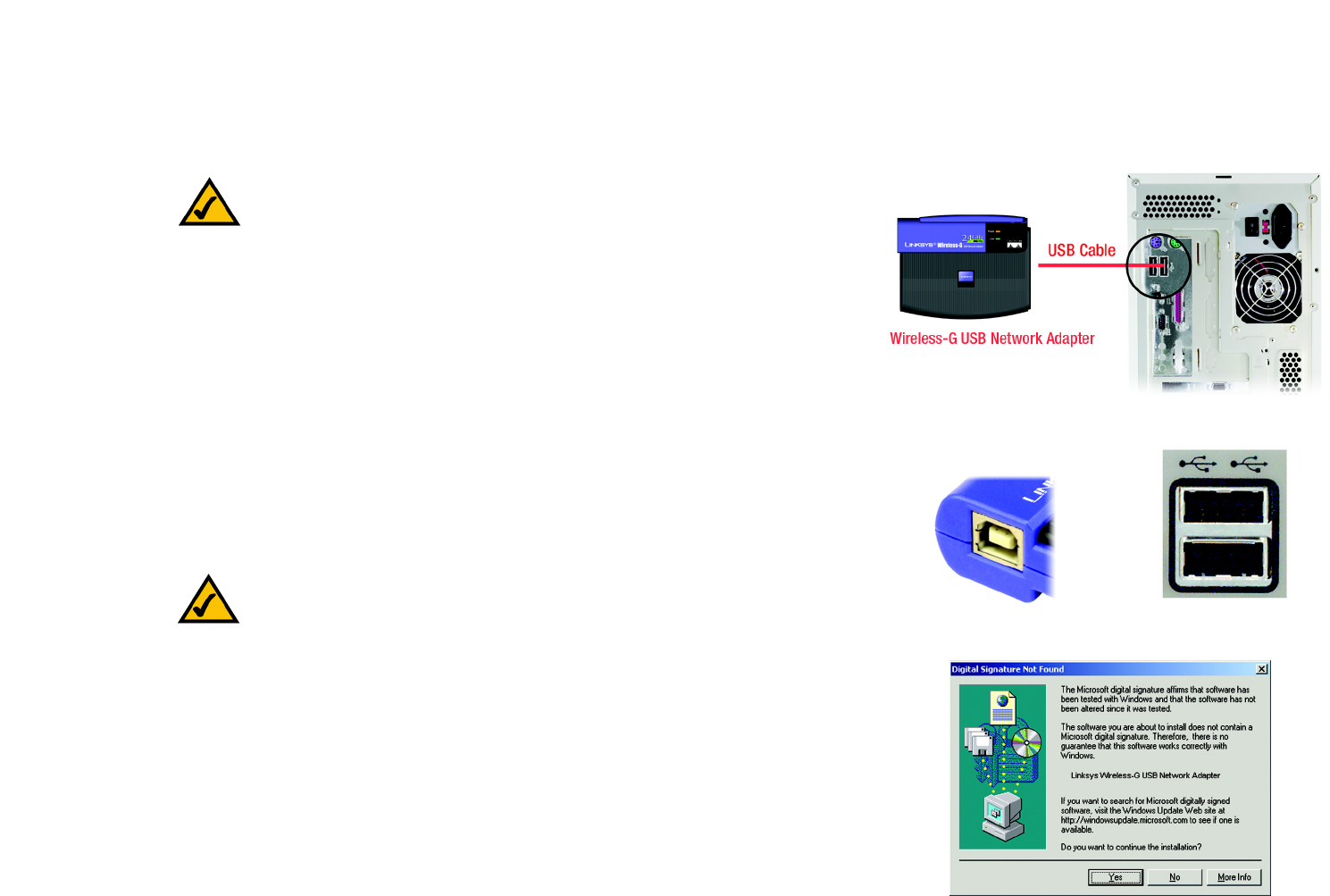LINKSYS WUSB54GV4 Wireless-G USB Network Adapter ver. 4 User Manual Book
LINKSYS LLC Wireless-G USB Network Adapter ver. 4 Book
LINKSYS >
Contents
- 1. User Manual Part 1
- 2. Users Manual Part 2
- 3. User Manual Part 3
Users Manual Part 2

13
Chapter 4: Setting up the Wireless-G USB Network Adapter
Using the Setup Wizard
Wireless-G USB Network Adapter
7. The Setup Wizard will ask you to review your settings before it starts to install files. Click Next if you are
satisfied with your settings, or click Back to change any settings.
8. At this point, you may see a Digital Signature Not Found screen indicating that a digital signature was not
found. The Adapter’s software has been tested and found to work successfully with Windows 2000. Click the
Yes button to continue.
9. After the software has been successfully installed, the Congratulations screen will appear. Click the Exit
button.
Proceed to “Chapter 5: Connecting the Wireless-G USB Network Adapter.”
Figure 4-13: Setup Wizard’s Check Settings Screen
Figure 4-15: Setup Wizard’s Congratulations Screen
Figure 4-14: Digital Signature Not Found Screen

14
Chapter 5: Connecting the Wireless-G USB Network Adapter
Connecting the Adapter
Wireless-G USB Network Adapter
Chapter 5: Connecting the Wireless-G USB Network Adapter
Connecting the Adapter
1. Connect one end of the included USB cable to the Adapter’s USB port.
2. Connect the other end of the cable to one of the USB ports on your computer.
3. The Power LED should light up when the Adapter is plugged in.
4. When Windows 2000 begins installing the Adapter’s driver, a Digital Signature Not Found screen may appear,
indicating that a digital signature was not found. This driver has been tested and found to work properly with
Windows 2000. Click the Yes button to continue the installation.
5. Raise the antenna. Make sure the antenna points straight up into the air, at a 90º angle from the Adapter. This
will ensure optimum wireless operating range and performance.
Congratulations! The installation of the Wireless-G Network Adapter is complete.
If you want to check the link information, search for available wireless networks, or make additional
configuration changes, go to “Chapter 6: Using the Wireless Network Monitor.”
Figure 5-1: How the Adapter Connects to Your PC
NOTE: You must run the Setup Wizard before connecting the Adapter.
Figure 5-2: Adapter’s USB Port Figure 5-3: PC’s USB Ports
NOTE: If you want to attach the Adapter to your wall, go to the next section,
“Using the Adapter’s Wall Mount,” before proceeding to “Chapter 6: Using the
Wireless Network Monitor.”
Figure 5-4: Digital Signature Not Found Screen

15
Chapter 5: Connecting the Wireless-G USB Network Adapter
Using the Adapter’s Wall Mount
Wireless-G USB Network Adapter
Using the Adapter’s Wall Mount
The Adapter’s Wall Mount allows you to easily attach the Adapter to your wall for better reception and more
convenient placement.
1. Attach the separate adhesive strip of velcro to the wall where you will be mounting the Adapter.
2. To attach the Wall Mount to the Adapter, slide the Wall Mount into the grooves on the back panel of Adapter, as
shown in Steps A, B, and C.
3. Using the velcro strip on the Adapter’s Wall Mount, attach the Adapter to the velcro strip on your wall.
Congratulations! The installation of the Wireless-G Network Adapter is complete.
If you want to check the link information, search for available wireless networks, or make additional
configuration changes, go to “Chapter 6: Using the Wireless Network Monitor.”
Figure 5-5: Using the Wall Mount - Step A
Figure 5-6: Using the Wall Mount - Step B
Figure 5-7: Using the Wall Mount - Step C

16
Chapter 6: Using the Wireless Network Monitor
Using the Wireless Network Monitor Icon
Wireless-G USB Network Adapter
Chapter 6: Using the Wireless Network Monitor
Use the Wireless Network Monitor to check the link information, search for available wireless networks, or create
profiles that hold different configuration settings.
Using the Wireless Network Monitor Icon
After installing the Adapter, the Wireless-G USB Network Adapter Wireless Monitor icon will appear in your
system tray. If the Wireless Network Monitor is enabled, then the icon will be green. If the Wireless Network
Monitor is disabled or the Adapter is not connected, then the icon will be gray.
If you right-click the icon, you will see these choices:
• About - Click About to view the version information for the driver and Wireless Network Monitor.
• Use Windows XP Wireless Configuration (Windows XP only) - If your computer is running Windows XP, then
this choice will be available. If you want to use Windows XP Wireless Zero Configuration to control the
Adapter—instead of using the Wireless Network Monitor—then select Use Windows XP Wireless
Configuration.
If you want to switch back to the Wireless Network Monitor, right-click the Wireless Network Monitor icon,
and select Use Linksys Wireless Network Monitor.
• Turn Monitor on - Select Turn Monitor on to enable the Wireless Network Monitor.
• Turn Monitor off - Select Turn Monitor off to disable the Wireless Network Monitor.
Figure 6-1: Wireless Network Monitor Icon
NOTE: For more information about Wireless Zero Configuration, refer
to Windows Help.
Figure 6-2: Windows XP - Use Windows XP
Wireless Configuration
Figure 6-3: Windows XP - Use Linksys
Wireless Network Monitor

17
Chapter 6: Using the Wireless Network Monitor
Accessing the Wireless Network Monitor
Wireless-G USB Network Adapter
Accessing the Wireless Network Monitor
Besides selecting Turn on when you right-click the icon, you can also double-click the Wireless Network
Monitor icon to activate the Wireless Network Monitor. Then the Link Information screen will appear. From this
screen, you can find out how strong the current wireless signal is and how good the connection’s quality is. You
can also click the More Information button to view additional status information about the current wireless
connection. To search for available wireless networks, click the Site Survey tab. To perform configuration
changes, click the Profiles tab.
Link Information
The Link Information screen displays network mode, signal strength, and link quality information about the
current connection. It also provides a button to click for additional status information.
Ad-Hoc Mode or Infrastructure Mode - The screen indicates whether the Adapter is currently working in ad-
hoc or infrastructure mode.
Signal Strength - The Signal Strength bar indicates signal strength.
Link Quality - The Link Quality bar indicates the quality of the wireless network connection.
Click the More Information button to view additional information about the wireless network connection.
Clicking the More Information button displays the Wireless Network Status screen, which displays more infor-
mation about the Adapter’s connection.
Figure 6-4: Link Information

18
Chapter 6: Using the Wireless Network Monitor
Link Information
Wireless-G USB Network Adapter
Wireless Network Status
The Wireless Network Status screen provides information on your current network settings.
Status - The status of the wireless network connection.
SSID - This is the unique name of the wireless network.
Wireless Mode - The mode of the wireless network currently in use is displayed here.
Transfer Rate - The data transfer rate of the current connection is shown here.
Channel - This is the channel to which the wireless network devices are set.
Security - The status of the wireless security feature is displayed here.
Authentication - This is your wireless network’s authentication method.
IP Address - The IP Address of the Adapter is displayed here.
Subnet Mask - The Subnet Mask of the Adapter is shown here.
Default Gateway - The Default Gateway address of the Adapter is displayed here.
DNS - This is the DNS address of the Adapter.
DHCP Client - This displays the Adapter’s status as a DHCP client.
MAC - The MAC address of the wireless network’s access point is shown here.
Signal Strength - The Signal Strength bar indicates the signal strength.
Link Quality - The Link Quality bar indicates the quality of the wireless network connection.
Click the Statistics button to go to the Wireless Network Statistics screen. Click the Back button to return to the
initial Link Information screen. Click the Save to Profile button to save the currently active connection settings to
a profile.
Figure 6-5: More Information - Wireless Network Status

19
Chapter 6: Using the Wireless Network Monitor
Link Information
Wireless-G USB Network Adapter
Wireless Network Statistics
The Wireless Networks Statistics screen provides statistics on your current network settings.
Transmit Rate - This is the data transfer rate of the current connection. (In Auto mode, the Adapter dynamically
shifts to the fastest data transfer rate possible at any given time.)
Receive Rate - This is the rate at which data is received.
Packets Received - This shows the packets received by the Adapter, in real time, since connecting to the
Wireless Network or since the Refresh Statistics button was last pressed.
Packets Transmitted - This shows the packets transmitted from the Adapter, in real time, since connecting to
the Wireless Network or since the Refresh Statistics button was last pressed.
Bytes Received - This shows the bytes received by the Adapter, in real time, since connecting to the Wireless
Network or since the Refresh Statistics button was last pressed.
Bytes Transmitted - This shows the bytes transmitted from the Adapter, in real time, since connecting to the
Wireless Network or since the Refresh Statistics button was last pressed.
Noise Level - This shows the level of background noise affecting the wireless signal. A lower reading translates
into a higher quality signal.
Signal Strength - This is the intensity of the wireless signal received by the Adapter.
Up Time - This indicates the length of the most recent connection to a wireless network.
Total Up Time - This indicates the cumulative total of the Adapter’s connection time.
Driver Version - This shows the version of the Adapter’s driver.
Signal Strength - The Signal Strength bar indicates the signal strength.
Link Quality - The Link Quality bar indicates the quality of the wireless network connection.
Click the Back button to return to the initial Link Information screen. Click the Status button to go to the Wireless
Network Status screen. Click the Save to Profile button to save the currently active connection settings to a
profile. Click the Refresh Statistics button to update or reset the statistics. The Wireless Network Monitor will
update the Transmit Rate, Receive Rate, Noise Level, and Signal Strength statistics. At the same time, the Packets
Received and Transmitted counts, Bytes Received and Transmitted counts, and Up Time statistic will be reset to
zero. (The Total Up Time statistic will not be reset.)
Figure 6-6: More Information-Network Statistics

20
Chapter 6: Using the Wireless Network Monitor
Site Survey
Wireless-G USB Network Adapter
Site Survey
The Site Survey screen displays a list of infrastructure and ad-hoc networks available for connection in the table
on the left. This table shows the network’s SSID, Channel, and the quality of the wireless signal the Adapter is
receiving. You may click SSID, CH (Channel), or Signal, to sort by that field.
SSID - The SSID or unique name of the wireless network is displayed here.
CH - This is the channel setting that the network uses.
Signal - This is the percentage of signal strength, from 0 to 100%.
Site Information
For each network selected, the following settings are listed:
SSID - This the SSID or unique name of the wireless network.
Wireless Mode - This is the mode of the wireless network currently in use.
Channel - This is the channel to which the wireless network devices are set.
Security - The status of the wireless security feature is displayed here.
MAC - The MAC address of the wireless network’s access point is displayed here.
Refresh - Click the Refresh button to perform a new search for wireless devices.
Connect - To connect to one of the networks on the list, select the wireless network, and click the Connect
button. If the network has encryption enabled, then you will see a new screen appear.
From the Security drop-down menu, select the network’s encryption method, WEP or PSK.
If you selected WEP, then you will see the WEP Key Needed for Connection screen. Select the appropriate level of
WEP encryption, 64-bit or 128-bit. Then enter the network’s Passphrase or WEP Key. Click the Connect button.
To cancel the connection, click the Cancel button.
If you selected PSK, then you will see the PSK (Pre-Shared Key) Needed for Connection screen. Select the
appropriate encryption type, TKIP or AES. Then enter the network’s Passphrase or Pre-Shared Key in the
Passphrase field. Then click the Connect button. To cancel the connection, click the Cancel button.
Figure 6-8: WEP Key Needed for Connection
Figure 6-9: PSK (Pre-Shared Key) Needed for Connection
Figure 6-7: Site Survey

21
Chapter 6: Using the Wireless Network Monitor
Profiles
Wireless-G USB Network Adapter
Profiles
The Profiles screen lets you save different configuration profiles for different network setups. The table on the left
displays a list of infrastructure and ad-hoc networks available for connection. This table shows the network’s
profile name and the wireless network’s SSID, as set in the connection profile.
Profile Information
For each profile selected, the following are listed:
Wireless Mode - This is the mode of the wireless network currently in use.
Transfer Rate - The Adapter is set to Auto mode, so it will dynamically shift to the fastest data transfer rate
possible at any given time.
Channel - This is the channel to which the wireless network devices are set.
Security - The status of the wireless security feature is displayed here.
Authentication - The authentication setting for the network is shown here.
Connect - To connect to a wireless network using a specific profile, select the profile, and click the Connect
button.
New - Click the New button to create a new profile. See the next section, “Creating a New Profile,” for detailed
instructions.
Edit - Select a profile, and click the Edit button to change an existing profile.
Import - Click the Import button to import a profile that has been saved in another location. Select the
appropriate file, and click the Open button.
Export - Select the profile you want to save in a different location, and click the Export button. Direct Windows to
the appropriate folder, and click the OK button.
Delete - Click the Delete button to delete a profile.
Figure 6-10: Profiles
Figure 6-11: Import a Profile
Figure 6-12: Export a Profile
NOTE: If you want to export more than one profile, you have to export them one at a time.

22
Chapter 6: Using the Wireless Network Monitor
Creating a New Profile
Wireless-G USB Network Adapter
Creating a New Profile
1. On the Profiles screen, click the New button to create a new profile.
2. Enter a name for the new profile, and click the OK button. Click the Cancel button to return to the Profiles
screen without entering a name.
3. The Network Settings screen will appear. If your network has a router or other DHCP server, click the radio
button next to Obtain network settings automatically (DHCP). Click the Next button to continue, or click
the Cancel button to return to the Profiles screen.
If your network does not have a DHCP server, click the radio button next to Specify the network settings.
Enter an IP Address, Subnet Mask, Default Gateway, and DNS address appropriate for your network. You must
specify the IP Address and Subnet Mask on this screen. If you are unsure about the Default Gateway and DNS
address, leave these fields empty. Click the Next button to continue, or click the Cancel button to return to
the Profiles screen.
IP Address - This IP Address must be unique to your network.
Subnet Mask - The Adapter’s Subnet Mask must be the same as your wired network’s Subnet Mask.
Default Gateway - Enter the IP address of your network’s Gateway here.
DNS 1 and DNS 2 - Enter the DNS address of your wired Ethernet network here.
Figure 6-13: Create a New Profile
Figure 6-14: Enter Profile Name
Figure 6-15: Network Settings for New Profile

23
Chapter 6: Using the Wireless Network Monitor
Creating a New Profile
Wireless-G USB Network Adapter
4. The Wireless Mode screen shows a choice of two wireless modes. Click the Infrastructure Mode radio
button if you want your wireless computers to communicate with computers on your wired network via a
wireless access point. Click the Ad-Hoc Mode radio button if you want multiple wireless computers to
communicate directly with each other. Enter the SSID for your network.
Click the Next button to continue or the Back button to return to the previous screen.
Infrastructure Mode - This mode allows wireless and wired networks to communicate through an access
point.
Ad-Hoc Mode - This mode allows wireless-equipped computers to communicate directly with each other. No
access point is used.
SSID - This is the network name. It must be used for all the devices in your wireless network. It is case-
sensitive. It should be a unique name to help prevent others from entering your network.
5. The Ad-Hoc Mode Settings screen will appear. If you chose Infrastructure Mode, go to Step 6 now. If you
chose Ad-Hoc Mode, select the correct operating channel for your network from the Channel drop-down
menu. Then, select the Network Mode from the drop-down menu. Click the Next button, and go to Step 6.
Click the Back button to change any settings.
Channel - The channel you choose should match the channel set on the other devices in your wireless
network. If you are unsure about which channel to use, select the default channel (Channel 6).
Network Mode - Select Mixed Mode, and both Wireless-G and Wireless-B computers will be allowed on the
network, but the speed may be reduced. Select G-Only Mode for maximum speed, but no Wireless-B users
will be allowed on the network.
Figure 6-16: Wireless Mode for New Profile
Figure 6-17: Ad-Hoc Mode Settings for New Profile

24
Chapter 6: Using the Wireless Network Monitor
Creating a New Profile
Wireless-G USB Network Adapter
6. Select the method of security you want to use: WEP, PSK, PSK + RADIUS, or RADIUS. WEP stands for Wired
Equivalent Privacy, and PSK stands for Pre-Shared Key. RADIUS stands for Remote Authentication Dial-In User
Service.
If you don’t want to use encryption, select Disabled and then click the Next button to continue. Proceed to
Step 8.
Click the Next button to continue or the Back button to return to the previous screen.
7. Proceed to the appropriate section for your security method: WEP, PSK, PSK-RADIUS, or RADIUS.
WEP
WEP - Select 64-bit or 128-bit encryption from the drop-down menu, and enter a passphrase or WEP key.
Passphrase - Enter a passphrase in the Passphrase field, so a WEP key is automatically generated. It is case-
sensitive and should not be longer than 16 alphanumeric characters. This passphrase must match the
passphrase of your other wireless network devices and is compatible with Linksys wireless products only. (If
you have any non-Linksys wireless products, enter the WEP key manually on those products.)
WEP Key - The WEP key you enter must match the WEP key of your wireless network. For 64-bit encryption,
enter exactly 10 hexadecimal characters. For 128-bit encryption, enter exactly 26 hexadecimal characters.
Valid hexadecimal characters are “0” to “9” and “A” to “F”.
Advanced Users
TX Key - The default transmit key number is 1. If your network’s access point or wireless router uses transmit
key number 2, 3, or 4, select the appropriate number from the TX Key drop-down box.
Authentication -The default is set to Auto, so it will auto-detect for Shared Key or Open System
authentication. For Shared Key authentication, both the sender and the recipient share a WEP key for
authentication. For Open System authentication, the sender and the recipient do not share a WEP key for
authentication. If you are not sure which authentication method to select, keep the default, Auto.
Click the Next button to continue. Click the Back button to return to the previous screen.
Figure 6-18: Wireless Security for New Profile
Figure 6-19: Wireless Security - WEP for New Profile
NOTE: If your network is using WPA-Personal or WPA-PSK security, then
select PSK. If your network is using WPA-Enterprise or WPA-RADIUS security,
then select PSK + RADIUS.